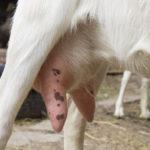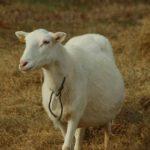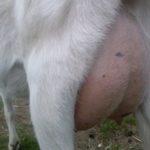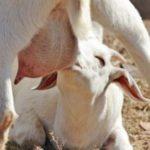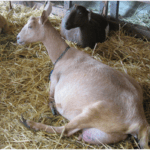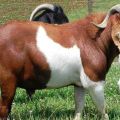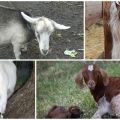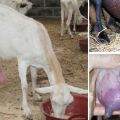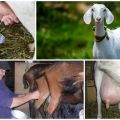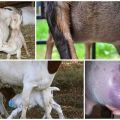Signs of lambing goat and what to do next, postpartum care and problems
Breeding pets requires knowledge of how to breed them. Childbirth is the most crucial moment in their life, on which the future productivity of cubs and queens depends. Healthy goats require minimal assistance from a breeder during lambing. But the creation of comfortable conditions of detention and how the animal is prepared for delivery depends on the person.
How to run a goat before lambing
In order for the goat to become normally angry, a start is made 45-60 days before lambing, which means the end of milking. With milk, she loses some of the nutrients produced in her body. Having stopped milking, the owner provides an opportunity for the full development of the kids. A normal pregnancy lasts 150 days. The breeder must be confident in the date of conception in order to accurately calculate when to prepare for lambing. The launch time is individual for each goat. Its beginning depends on the fatness of the animals: the thin ones are milked in 1.5-2 months, the well-fed - in a month.
The frequency of milking and the amount of milk to be milked are gradually reduced so as not to harm the health of the goat and not to reduce milk yield in the future.
Milk yield reduction table.
| Launch week | Milking frequency | Milk volume per milk |
| 1 2 3 4 | 1 / day 1 / 1.5 days 1/2 days periodically | 1 liter 0.5 liter 0.3 liters 0.2 liters |
With a longer period of preparation for childbirth, the schedule changes. In some goats, milk production naturally decreases before lambing. During start-up, you should monitor the condition of the udder so as not to cause mastitis. If it turns to stone, it is necessary to massage and remove the accumulated colostrum.
In the precoat period, changes are made to the goat's diet:
- In the first 7 days of launch, the share of succulent feed, concentrates, greens is reduced.
- 14 days before lambing, the volume of concentrated feed is reduced by 2 times.
- With the termination of milking, concentrates are given 2 times more than before starting.
- 3-4 days before giving birth, stop giving vegetables.
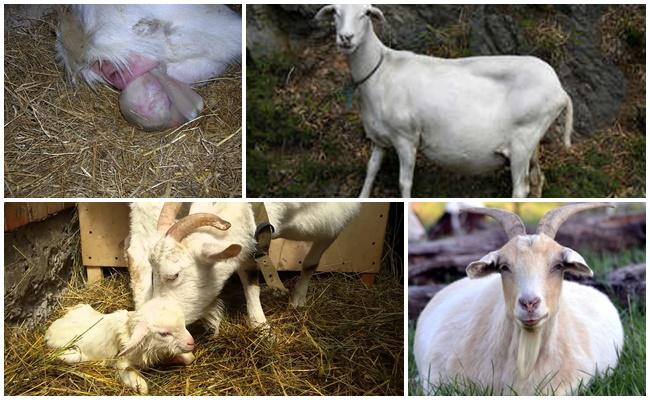
The goat should not be given rotten, moldy vegetables. Potatoes, beets, carrots should be added boiled to the diet. The water should be warm, with wheat bran. Exclude turnips, cabbage and juicy tops, which cause fermentation in the intestines.
How many days before lambing does a goat's udder fill?
Goat catniness is not always noticeable by the size of the belly and for a long time, especially in long-haired and downy breeds. Check if the goat is covered by the pattern of the genital loop. A clear sign of pregnancy is an enlarged udder.
Colostrum production and udder swelling most often become noticeable 45-60 days before delivery.In dairy goats, before lambing, the udder may increase so much that colostrum has to be milked to avoid mastitis. Udder swelling depends on the individual characteristics of the animal.
The udder is soft and empty for the first week after starting. After 3 months of pregnancy, the animal's body prepares for milk production: the glandular tissue of the udder begins to grow and produce colostrum. In re-feeding goats, it pours and hardens a week before lambing, in first-flow goats - in 1-2 days.
Animal behavior
To find out about the upcoming birth, you need to carefully monitor the goat in the last weeks of pregnancy.
Harbingers of Lambing:
- opening of the vagina, exit of the mucous plug;
- anxiety of the goat, which lies down, then gets up, screams;
- finding a secluded place;
- aggressiveness towards other animals;
This state lasts about 2 hours, after which lambing sets in. In the firstborn, it lasts from 1 to 1.5 hours. On the second and subsequent births - about 40 minutes.
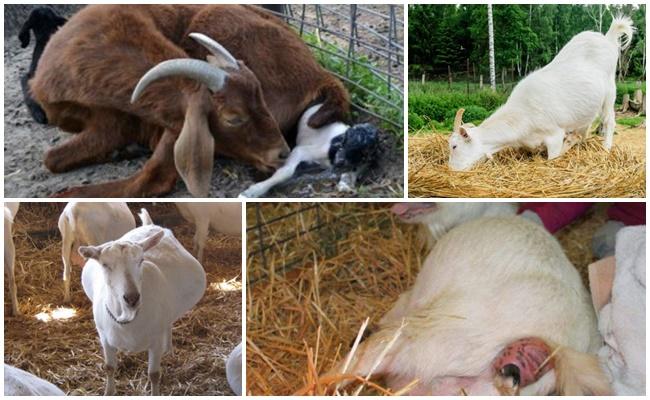
Do you need human help?
The breeder should prepare the lambing area so that newborns and goats do not have postpartum complications. The room where the animals are kept is cleaned of manure a week before the lambing date, the floor is treated with a lime solution (1 kilogram per bucket of water). For the goat, they choose a secluded place with a drinker and a feeder, fenced off from other animals, which is covered with a thick layer of straw the day before the approaching birth.
How to deliver
In the normal course of childbirth, the whole process takes place without human intervention and lasts from 2 hours to 40 minutes.
- Part of the bladder comes out of the vagina, bursts.
- Water drain.
- Together with the bladder, the head of the kid and the front legs begins to "cut through".
- The whole cub comes out.
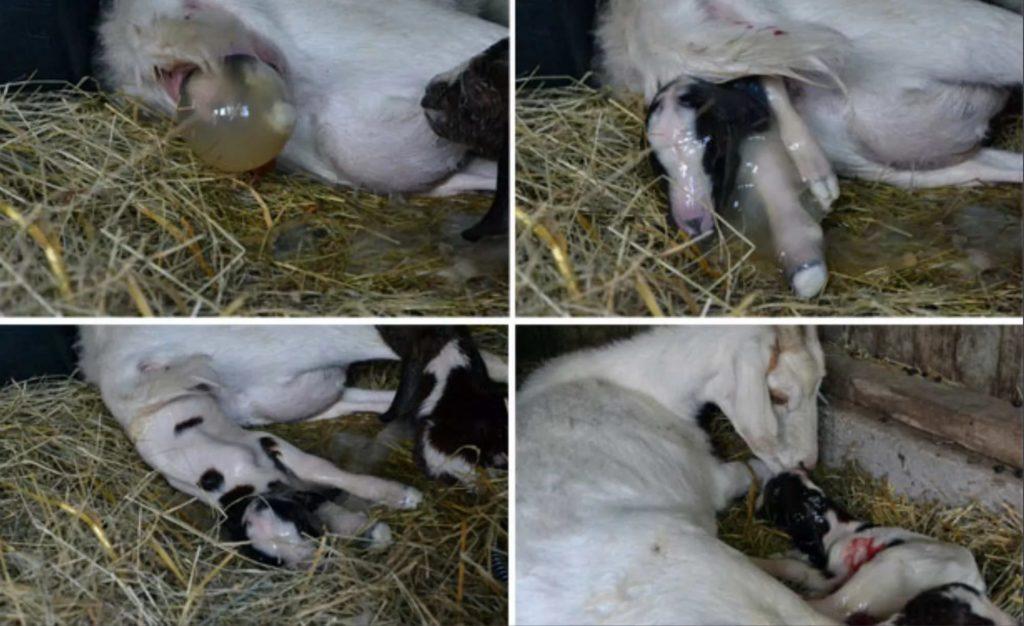
Goats give birth while lying on their side. After the kid appears, they get up to lick it. With the onset of new contractions, they again lie on their side to give birth to another cub. By taking part in lambing, breeders help the animals save energy for labor: they remove the kid from under their feet, transfer it to the mother's face. Taking into account the number of calves, the release of the placenta, lambing takes up to 3-5 hours in time. The remnants of mucus and water are washed off from the croup and thighs of animals with a 4% solution of baking soda. The dirty litter is replaced with a fresh one.
Care after lambing
Newborn babies and a lambing goat need human participation. For the kids, the first minutes of their independent life are important, and for the goat - postpartum recovery.
Goat
Immediately after lambing, the goat is given sweetened water. After 1.5 hours, give hay and fresh water. The next portions of water are offered to the goat every 3-4 hours. The first week after giving birth, the goat is distributed 4 times a day, trying to drain the milk completely. To facilitate the process, the udder is pre-massaged with soft, circular movements towards the milking. The first 4 days feed is given in small portions 3-4 times a day. Be sure to include 300 grams of bran in the diet to restore digestion.
Starting from 5 days, the composition of the feed includes:
- hay (2 kilograms);
- root vegetables (3 kilograms);
- bran (400 grams);
- concentrates (0.5 kilograms);
- salt (10 grams);
- branch feed (1 kilogram).
After transferring the pups to pasture, the animal is transferred to a regular diet.
For the young
A newborn kid is cleared of mucus from the nose and mouth. If the baby comes out in the amniotic sac, then the film is torn to prevent asphyxiation. The kid must scream at birth in order to draw air into the lungs and begin to breathe on its own.If he is silent, you need to blow in his nose or open mouth. In the absence of breathing, the kid is placed on its back and, bending-unbending its legs, make its lungs work.
The goat should lick the kid and then wipe it dry with a rag or straw. The umbilical cord is tied with a thread soaked in iodine at a distance of 2-3 centimeters from the abdomen. They retreat from the sling by 1 centimeter, cut off the umbilical cord, cut the cut with iodine. If the goat is supposed to be feeding, then you should make sure that it will allow the cub to the udder.
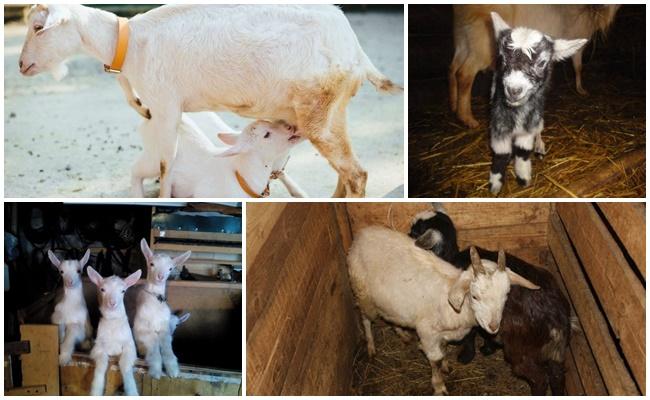
When fed with expressed milk, the kids are removed from the uterus and taken to the house. The first portions of colostrum can be contaminated, so before the first feeding, some of the colostrum is expressed and poured out. If the kids are breastfed, then they are constantly with the mother. Feeding the cubs with expressed milk is established by breeders of dairy goats to preserve milk yield. Caring for healthy offspring is easy. Toddlers should have enough space in the goat house or paddock for playful games.
What to do if a goat cannot give birth
Goats have pathological childbirth, when human help is required to speed up labor and prevent the death of the calf and calving. For this reason, it is necessary to observe how the lambing process proceeds in order to intervene in a timely manner. In what cases it is necessary to help with lambing:
- if the baby's head does not come out;
- the kid walks with its legs;
- the afterbirth is not separated.
With weak labor, the inexperience of the first-born, a large fetus, the baby gets stuck in the birth canal and may suffocate. To help him be born, you should thoroughly wash and rub your hands with alcohol. Lubricate the walls of the vagina with boric petroleum jelly. With each push, when the goat begins to scream, gently pull the fetus towards the udder until it comes out completely.
If the fetus is not presented correctly, a veterinarian should be called, otherwise both the uterus and the cub may die. Breeders care when lambing is delayed. Recurring may be associated with intrauterine fetal death or poor labor, especially if it is a firstborn. Veterinarians recommend not rushing to put oxytocin until the due date does not exceed 10 days.
Other problems
A pregnant goat must be observed in order to notice pathological abnormalities in time. For example, when before the due date of her mucus leaves. This means that lambing will begin earlier and the kids will be born prematurely. The animal should be shown to the veterinarian, who will give advice on how to act for the breeder in case of premature birth.
Distribution errors lead to an inflammatory process in the mammary gland, mastitis. The udder hardens and the animal experiences pain during milking. Milk becomes unsuitable for raising kids and eating. To solve the problem, you should contact your veterinarian.
